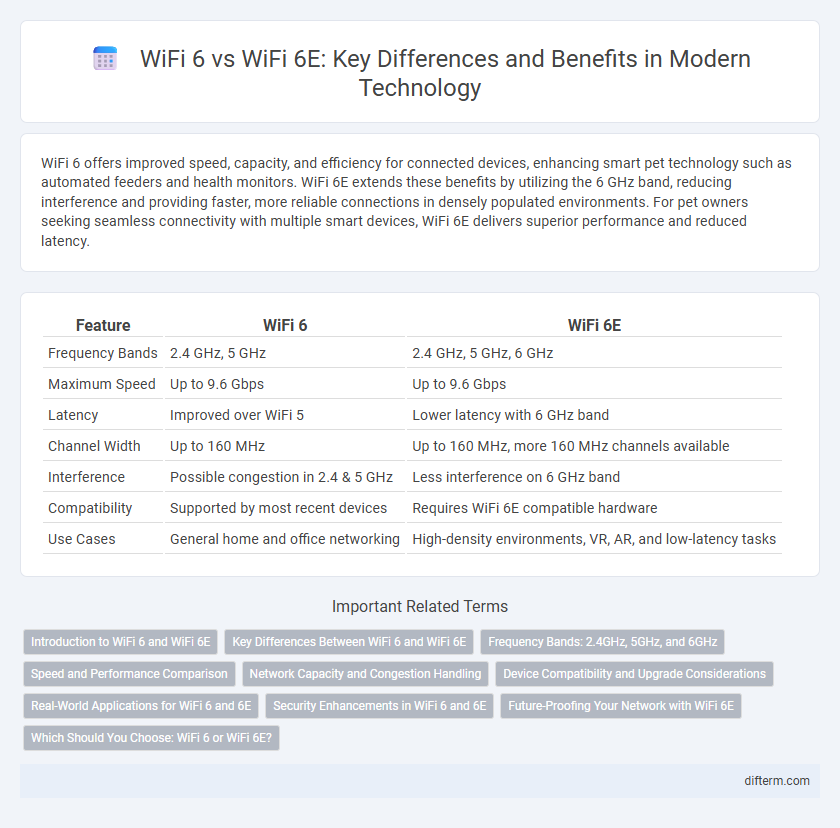WiFi 6 offers improved speed, capacity, and efficiency for connected devices, enhancing smart pet technology such as automated feeders and health monitors. WiFi 6E extends these benefits by utilizing the 6 GHz band, reducing interference and providing faster, more reliable connections in densely populated environments. For pet owners seeking seamless connectivity with multiple smart devices, WiFi 6E delivers superior performance and reduced latency.
Table of Comparison
| Feature | WiFi 6 | WiFi 6E |
|---|---|---|
| Frequency Bands | 2.4 GHz, 5 GHz | 2.4 GHz, 5 GHz, 6 GHz |
| Maximum Speed | Up to 9.6 Gbps | Up to 9.6 Gbps |
| Latency | Improved over WiFi 5 | Lower latency with 6 GHz band |
| Channel Width | Up to 160 MHz | Up to 160 MHz, more 160 MHz channels available |
| Interference | Possible congestion in 2.4 & 5 GHz | Less interference on 6 GHz band |
| Compatibility | Supported by most recent devices | Requires WiFi 6E compatible hardware |
| Use Cases | General home and office networking | High-density environments, VR, AR, and low-latency tasks |
Introduction to WiFi 6 and WiFi 6E
WiFi 6, based on the IEEE 802.11ax standard, significantly improves network efficiency, speed, and capacity by utilizing OFDMA and MU-MIMO technologies, ideal for congested environments. WiFi 6E extends WiFi 6 capabilities by operating in the newly allocated 6 GHz band, offering increased bandwidth, reduced interference, and lower latency for faster and more reliable wireless connections. This extension supports higher device densities and enhances performance in smart homes, offices, and high-traffic public spaces.
Key Differences Between WiFi 6 and WiFi 6E
WiFi 6 operates primarily on the 2.4 GHz and 5 GHz bands, while WiFi 6E extends these capabilities into the 6 GHz spectrum, offering additional channels that reduce congestion and latency. WiFi 6E supports up to 14 more 80 MHz channels and 7 more 160 MHz channels, enabling faster data rates and improved performance in dense environments. Enhanced spectrum availability in WiFi 6E significantly benefits applications requiring low latency and high throughput, such as augmented reality and high-definition video streaming.
Frequency Bands: 2.4GHz, 5GHz, and 6GHz
WiFi 6 operates on the 2.4GHz and 5GHz frequency bands, supporting faster speeds and improved capacity over previous standards. WiFi 6E expands this capability by adding access to the 6GHz band, significantly increasing available spectrum and reducing interference for enhanced performance in dense environments. The inclusion of the 6GHz frequency in WiFi 6E allows for more simultaneous connections and higher throughput compared to WiFi 6's dual-band operation.
Speed and Performance Comparison
WiFi 6E extends WiFi 6 by utilizing the 6 GHz band, offering significantly higher speeds and reduced latency with up to 7 additional 20 MHz channels compared to WiFi 6's 5 GHz spectrum. This expansion results in improved performance for high-bandwidth applications and dense environments, providing peak data rates up to 9.6 Gbps. WiFi 6E also experiences less interference, enhancing overall reliability and throughput in congested wireless networks.
Network Capacity and Congestion Handling
WiFi 6E expands upon WiFi 6 by utilizing the 6 GHz band, significantly increasing network capacity and reducing congestion compared to the traditional 2.4 GHz and 5 GHz bands. This additional spectrum provides more non-overlapping channels, enabling better performance in densely populated environments with multiple connected devices. Enhanced orthogonal frequency-division multiple access (OFDMA) and improved spatial frequency reuse techniques in WiFi 6E optimize data transmission efficiency and minimize interference.
Device Compatibility and Upgrade Considerations
WiFi 6E expands the traditional WiFi 6 spectrum by operating in the 6 GHz band, offering less congestion and higher throughput but requires devices equipped with compatible 6E chipsets, limiting immediate widespread adoption. Existing WiFi 6 devices remain fully functional on 2.4 GHz and 5 GHz bands, ensuring backward compatibility without mandatory hardware upgrades. Evaluating smart home ecosystems, mobile devices, and enterprise infrastructure for 6 GHz compatibility is crucial before transitioning to WiFi 6E to maximize network performance benefits.
Real-World Applications for WiFi 6 and 6E
WiFi 6 delivers enhanced performance in dense environments like offices and crowded public spaces by improving speed, capacity, and latency through OFDMA and MU-MIMO technologies. WiFi 6E expands these advantages into the 6 GHz band, enabling additional spectrum and less interference, which benefits high-bandwidth applications such as augmented reality, virtual reality, and 4K/8K video streaming. Real-world deployments of WiFi 6E show significant improvements in device density management and ultra-low latency for next-generation smart home systems and industrial IoT networks.
Security Enhancements in WiFi 6 and 6E
WiFi 6 and WiFi 6E both introduce WPA3 encryption, greatly enhancing network security by providing stronger password protection and individualized data encryption. WiFi 6E expands these improvements by operating in the 6 GHz band, reducing interference and allowing for more secure, high-capacity connections. Enhanced authentication protocols and improved management frame protection in WiFi 6E further prevent unauthorized access and safeguard against eavesdropping.
Future-Proofing Your Network with WiFi 6E
WiFi 6E extends the capabilities of WiFi 6 by operating in the 6 GHz band, offering increased spectrum availability, reduced interference, and higher data throughput for future-proofing your network. This expanded frequency range supports more simultaneous device connections, critical as smart homes and IoT ecosystems continue to grow. Investing in WiFi 6E ensures enhanced network performance and scalability, meeting the demands of emerging technologies and high-bandwidth applications.
Which Should You Choose: WiFi 6 or WiFi 6E?
WiFi 6E extends WiFi 6 by operating in the 6 GHz band, offering less interference and higher capacity for devices in congested environments. Choosing WiFi 6 is suitable for users with older hardware or limited need for ultra-fast speeds, while WiFi 6E is ideal for future-proofing with faster data rates and reduced latency in compatible devices. Consider device compatibility and network environment to decide between the broader support of WiFi 6 and the enhanced performance of WiFi 6E.
WiFi 6 vs WiFi 6E Infographic

 difterm.com
difterm.com